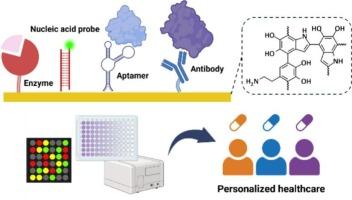裁剪生物传感器接口:多多巴胺辅助表面功能化实现生物识别
IF 22
1区 材料科学
Q1 MATERIALS SCIENCE, MULTIDISCIPLINARY
引用次数: 0
摘要
基于聚多巴胺(pDA)的表面工程作为一种增强生物传感平台性能的生物启发和通用策略已经引起了极大的关注。它对各种基材的强附着力,加上出色的生物相容性,使其能够无缝集成到各种传感系统中。本文综述了pda基涂层的最新进展,重点介绍了合成策略、表面功能化技术及其在生物流体中生物标志物检测的生物传感器中的应用。特别强调的是固定技术的蛋白质为基础的生物受体,核酸和阻断剂用于减少非特异性相互作用。此外,还讨论了工程pDA作为分子印迹合成受体的新应用。尽管目前的方法仍然主要局限于实验室环境,并且需要验证可扩展的生产,但本综述设想将分子水平的见解与实际设计策略相结合,以推动下一代pda生物传感技术的发展。本文章由计算机程序翻译,如有差异,请以英文原文为准。

Tailoring Biosensor Interfaces: Polydopamine-Assisted Surface Functionalization for Enabling Biorecognition
Polydopamine (pDA)–based surface engineering has garnered significant attention as a bioinspired and versatile strategy for enhancing the performance of biosensing platforms. Its strong adhesion to a wide range of substrates, combined with excellent biocompatibility, enables seamless integration into diverse sensing systems. This review summarizes recent advances in pDA-based coatings, with a particular focus on synthetic strategies, surface functionalization techniques, and their applications in biosensors for biomarker detection in biofluids. Special emphasis is placed on immobilization techniques for protein-based bioreceptors, nucleic acids, and blocking agents used to minimize nonspecific interactions. Furthermore, emerging applications of engineered pDA as synthetic receptors via molecular imprinting are discussed. Although current approaches remain largely limited to laboratory settings and require validation for scalable production, this review envisions the integration of molecular-level insights with practical design strategies to drive the development of next-generation pDA-enabled biosensing technologies.
求助全文
通过发布文献求助,成功后即可免费获取论文全文。
去求助
来源期刊

Materials Today
工程技术-材料科学:综合
CiteScore
36.30
自引率
1.20%
发文量
237
审稿时长
23 days
期刊介绍:
Materials Today is the leading journal in the Materials Today family, focusing on the latest and most impactful work in the materials science community. With a reputation for excellence in news and reviews, the journal has now expanded its coverage to include original research and aims to be at the forefront of the field.
We welcome comprehensive articles, short communications, and review articles from established leaders in the rapidly evolving fields of materials science and related disciplines. We strive to provide authors with rigorous peer review, fast publication, and maximum exposure for their work. While we only accept the most significant manuscripts, our speedy evaluation process ensures that there are no unnecessary publication delays.
 求助内容:
求助内容: 应助结果提醒方式:
应助结果提醒方式:


